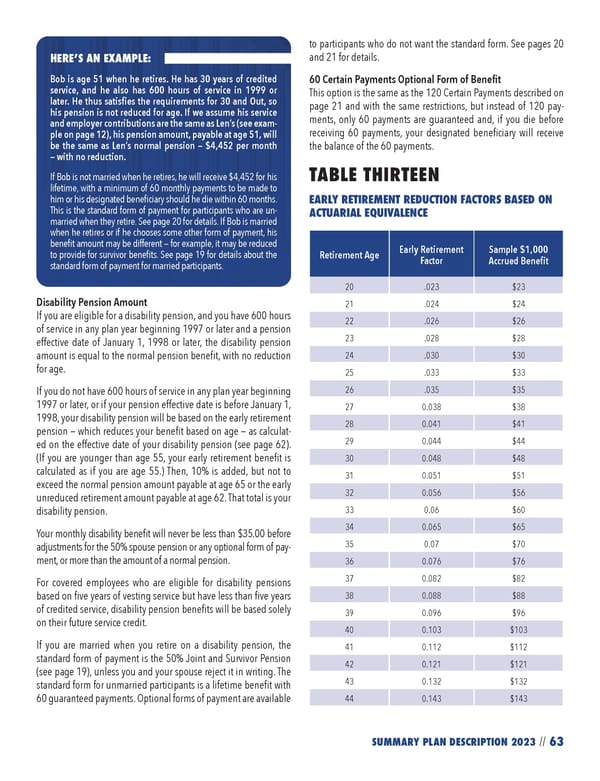63 SUMMARY PLAN DESCRIPTION 2023 // Disability Pension Amount If you are eligible for a disability pension, and you have 600 hours of service in any plan year beginning 1997 or later and a pension effective date of January 1, 1998 or later, the disability pension amount is equal to the normal pension benefit, with no reduction for age. If you do not have 600 hours of service in any plan year beginning 1997 or later, or if your pension effective date is before January 1, 1998, your disability pension will be based on the early retirement pension — which reduces your benefit based on age — as calculat- ed on the effective date of your disability pension (see page 62). (If you are younger than age 55, your early retirement benefit is calculated as if you are age 55.) Then, 10% is added, but not to exceed the normal pension amount payable at age 65 or the early unreduced retirement amount payable at age 62. That total is your disability pension. Your monthly disability benefit will never be less than $35.00 before adjustments for the 50% spouse pension or any optional form of pay- ment, or more than the amount of a normal pension. For covered employees who are eligible for disability pensions based on five years of vesting service but have less than five years of credited service, disability pension benefits will be based solely on their future service credit. If you are married when you retire on a disability pension, the standard form of payment is the 50% Joint and Survivor Pension (see page 19), unless you and your spouse reject it in writing. The standard form for unmarried participants is a lifetime benefit with 60 guaranteed payments. Optional forms of payment are available to participants who do not want the standard form. See pages 20 and 21 for details. 60 Certain Payments Optional Form of Benefit This option is the same as the 120 Certain Payments described on page 21 and with the same restrictions, but instead of 120 pay- ments, only 60 payments are guaranteed and, if you die before receiving 60 payments, your designated beneficiary will receive the balance of the 60 payments. TABLE THIRTEEN EARLY RETIREMENT REDUCTION FACTORS BASED ON ACTUARIAL EQUIVALENCE Retirement Age Early Retirement Factor Sample $1,000 Accrued Benefit 20 .023 $23 21 .024 $24 22 .026 $26 23 .028 $28 24 .030 $30 25 .033 $33 26 .035 $35 27 0.038 $38 28 0.041 $41 29 0.044 $44 30 0.048 $48 31 0.051 $51 32 0.056 $56 33 0.06 $60 34 0.065 $65 35 0.07 $70 36 0.076 $76 37 0.082 $82 38 0.088 $88 39 0.096 $96 40 0.103 $103 41 0.112 $112 42 0.121 $121 43 0.132 $132 44 0.143 $143 HERE’S AN EXAMPLE: Bob is age 51 when he retires. He has 30 years of credited service, and he also has 600 hours of service in 1999 or later. He thus satisfies the requirements for 30 and Out, so his pension is not reduced for age. If we assume his service and employer contributions are the same as Len’s (see exam- ple on page 12), his pension amount, payable at age 51, will be the same as Len’s normal pension — $4,452 per month — with no reduction. If Bob is not married when he retires, he will receive $4,452 for his lifetime, with a minimum of 60 monthly payments to be made to him or his designated beneficiary should he die within 60 months. This is the standard form of payment for participants who are un- married when they retire. See page 20 for details. If Bob is married when he retires or if he chooses some other form of payment, his benefit amount may be different — for example, it may be reduced to provide for survivor benefits. See page 19 for details about the standard form of payment for married participants.
 2023 NPF Summary Plan Description Page 64 Page 66
2023 NPF Summary Plan Description Page 64 Page 66